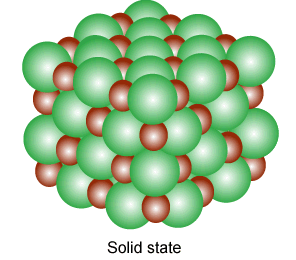Question:
A metal crystallises in a bcc lattice. Its unit cell edge length is about 300 pm and its molar mass is about $50\, g\, mol^{-1}$. What would be the density of the metal (in $g\, cm^{-3}$)?
A metal crystallises in a bcc lattice. Its unit cell edge length is about 300 pm and its molar mass is about $50\, g\, mol^{-1}$. What would be the density of the metal (in $g\, cm^{-3}$)?
Updated On: Jul 5, 2022
- 3.1
- 6.2
- 9.3
- 12.4
Hide Solution
Verified By Collegedunia
The Correct Option is B
Solution and Explanation
$a = 300\, pm,\, Z = 2$ (for bcc unit cell)
$M = 50 \,g\,mol^{-1}$
Density, $\rho = \frac{Z\times M}{N_{A} \times a^{3}\times 10^{-30}} g \,cm^{-3}$
$= \frac{2\times 50}{N_{A}\times 10^{23}\times \left(300\right)^{3}\times 10^{-30}} =\frac{100}{6.02\times 27\times 10^{-1}}$
$= \frac{1000}{6.02\times 27} = 6.15\,g\,cm^{-3} \approx 6.2\,g \,cm^{-3}$
Was this answer helpful?
0
0
Top Questions on The solid state
- A metal crystallises in two cubic phases, fcc and bcc with edge lengths 3.5 Å and 3 Å respectively. The ratio of densities of fcc and bcc is approximately
- TS EAMCET - 2025
- Chemistry
- The solid state
- How many kinds of Bravais lattice are possible in a crystal?
- Bihar Board XII - 2025
- Chemistry
- The solid state
- The percentage of free space in a body-centred cubic unit cell is
- Bihar Board XII - 2025
- Chemistry
- The solid state
- The number of atoms present in body-centred cubic unit cell is
- Bihar Board XII - 2025
- Chemistry
- The solid state
- Which of the following is not a crystalline solid?
- Bihar Board XII - 2025
- Chemistry
- The solid state
View More Questions
Concepts Used:
Solid State
Solids are substances that are featured by a definite shape, volume, and high density. In the solid-state, the composed particles are arranged in several manners. Solid-state, in simple terms, means "no moving parts." Thus solid-state electronic devices are the ones inclusive of solid components that don’t change their position. Solid is a state of matter where the composed particles are arranged close to each other. The composed particles can be either atoms, molecules, or ions.

Types of Solids:
Based on the nature of the order that is present in the arrangement of their constituent particles solids can be divided into two types;
- Amorphous solids behave the same as super cool liquids due to the arrangement of constituent particles in short-range order. They are isotropic and have a broad melting point (range is about greater than 5°C).
- Crystalline solids have a fixed shape and the constituent particles are arranged in a long-range order.